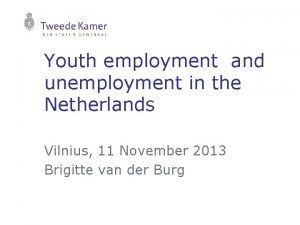Youth employment and unemployment in the Netherlands Vilnius


















- Slides: 18

Youth employment and unemployment in the Netherlands Vilnius, 11 November 2013 Brigitte van der Burg

Outline 1. ‘The Dutch economy’ and employment situation 2. Policy framework – Education – Labour market and social security 3. Initiatives on youth unemployment

1. The Netherlands (key statistics) Population: 16. 715 million Density: 404, 5/km² GDP: € 537. 192. 383 GDP per capita: € 32. 139

The Netherlands at a glance: the economy Services • 70% of employees work in the service sector • Services generate almost 75% of total added value • Focus areas are transport, logistics, banking and insurance Foreign trade • Export of goods and services 83% of GDP • Import of goods and services 74% of GDP Industrial activity Food processing, chemicals, petroleum refining and electrical machinery

Youth unemployment is relatively low Youth unemployment (under 25 years), June 2013 (or latest available) Source: Eurostat

Youth unemployment in The Netherlands (January 2003 – September 2013) Youth unemployment (ILO-definition) Source: Centraal Bureau voor de Statistiek

2. Policy framework How the systems contribute to youth employment in The Netherlands. 1. Education Vocational Education and Training (VET) Early school leavers 2. Labour market policies and social security Labour market and institutions Activating social security Minimum wages

The importance of an early labour market debut “A key factor behind the successful labour market performance is the early labour market debut for many young people, facilitating later transition into full time position and permanent contracts” Source: OECD (2012), Economic Surveys The Netherlands Apprenticeships as a vital element in the Dutch educational system

Vocational Education & Training (VET) in the Netherlands

Drop outs and early school leaving • Labour market perspectives of qualified school-leavers are much better than those of unqualified school-leavers; • Therefore, policies focus on reducing the number of early school-leavers; • Objective: the number of new early school-leavers must be reduced to 25. 000 in 2016.

Reduction of the number of early school-leavers Achievement 2011: 38. 600 (2, 9%) New dropouts: Target and achievement Source: Ministry of Education, Culture and Sciences, Key figures 2007 - 2011

2. Policy framework How the systems contribute to youth employment in The Netherlands. 1. Education Vocational Education and Training (VET) Early school leavers 2. Labour market policies and social security Labour market and institutions Activating social security Minimum wages

Well functioning labour markets offer opportunities for all ‘The well performing labour market has delivered low unemployment and relatively stable wage developments. ’ Source: OECD (2012), Economic Surveys The Netherlands • The dutch labour market performs well, also for young people: • Relatively low youth unemployment and high youth employment • Flexible contracts as screening mechanism for employers and ‘stepping stone’

Activating social security Social security = safety net with a strong focus on activation and personal responsibility. Social security for young people (special regime < 27 years) If young people want to qualify for benefits: » They have to search actively during 4 weeks for a job or education before they can apply » Reintegration into the labor market is decentralized to municipalities. If young people apply for benefits, municipalities and unemployed young people make a proposal for reintegration » Municipalities cooperate with among others the public employment service, educational institutions, employers and health care providers

Minimum wages affect employment probabilities There seems to be a causal relation between the relatively low minimum wages and relative good labour market outcomes in The Netherlands (CPB, 2012). 100% 80% 60% IR: 70% UK: 74% POR: 75% SL: 75% United Kingdom Portugal Slovak Republic LUX: 78% NZ: 80% B: 82% CZ: 85% FR: 85% Belgium Czech Republic France NL: 57% 40% 20% 0% Netherlands Ireland Luxembourg New Zealand Average minimum youth wage as a percentage of adult minimum wage Source: OECD (2008), Jobs for youth

Minimum (youth)wages in the Netherlands € 1, 600. 00 23 € 1, 400. 00 22 € 1, 200. 00 21 € 1, 000. 00 20 19 € 800. 00 18 17 € 600. 00 15 16 € 400. 00 € 200. 00 € 0. 00 15 16 17 18 19 Gross monthly minimum (youth) wages by age, 1 July 2013 Source: Ministry of Social Affairs and Employment 20 21 22 23

3. Specific initiatives

A multidisciplinary approach • Additional budget for labour market regions, for specific and dedicated activities • Co-financing for sectoral plans by social partners (possibility of ESF) • School-Ex programme to stimulate students in secondary VET to stay longer in education and choose labour market relevant school curricula
 Project proposal for unemployed youth
Project proposal for unemployed youth Express-group-routes
Express-group-routes Mru library
Mru library Donatas burneika
Donatas burneika Vilnius antakalnis gymnasium
Vilnius antakalnis gymnasium Lithuania dmc
Lithuania dmc Art nouveau vilnius
Art nouveau vilnius Vilnius university press
Vilnius university press Vilniaus maironio progimnazija
Vilniaus maironio progimnazija Lhmt krituliai
Lhmt krituliai Vilnius gediminas technical university erasmus
Vilnius gediminas technical university erasmus Mediolekt beispiel
Mediolekt beispiel Heliopolis organinis stiklas
Heliopolis organinis stiklas Primark globalisation
Primark globalisation Netherlands latitude and longitude
Netherlands latitude and longitude Supply side unemployment
Supply side unemployment Chapter 28 unemployment
Chapter 28 unemployment Relationship between inflation and unemployment
Relationship between inflation and unemployment Aims and objectives of unemployment
Aims and objectives of unemployment



































